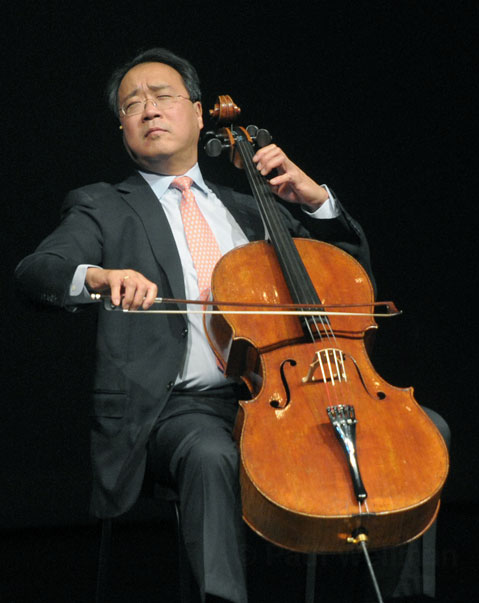Yo-Yo Ma Lecture/Performance at the Granada Theatre
UCSB’s Arts & Lectures Presented “Reflections on a Life in Music” on Thursday, April 5
Although the lecture portion of Yo-Yo Ma’s performance at the Granada Theatre was given strictly in prose, the great musician and master cellist still managed to fulfill Sir Phillip Sidney’s classic definition of poetry by producing “a speaking picture with this end, to teach and delight.” Ma’s humble presentation of his own life story through words, pictures, and musical examples was filled with gestures and images that lingered in the mind as their deeper meanings unfolded, making this one of the year’s most satisfying and inspirational cultural events. Beginning with an excerpt from the Bach Cello Suites for which he is so well-known, Ma invited the audience to share their mental images for the music immediately after he finished playing. As he gathered the various responses — “flowing water,” “birds flying” — Ma praised the audience members for their contribution, concluding the segment by telling us, “Your responses add another layer to the experience.”

From there, Ma unfolded his life story. Accompanied by video clips and photographs, he presented a series of vignettes designed to illustrate certain principles that guided specific decisions he made in his career. For example, his inspiration for the Silk Road Project began in failure. He had put together a kind of super-group with bassist Edgar Meyer and violinist Mark O’Connor, and they were meeting once a month, but although Ma at first thought everything was great, Meyer was less enthusiastic about their early efforts. Then O’Connor told Ma about his mentor, Benny Thomasson, the greatest of the old-time Texas fiddlers. When Ma innocently inquired, “Where does he teach?” he learned that Thomasson didn’t hold a position at a school of music and wasn’t even a “professional” musician. He held a day job as a car mechanic in Seattle, and O’Connor had never once paid him for a lesson.
This set Ma to thinking; “Maybe there are other Benny Thomassons out there — great musicians who will never receive the kind of recognition that me and my colleagues assume as a given of success.” Next came a historian who asked Ma what he knew about his cello, to which Ma replied, “Everything! Where it was made — Italy — who it was made by, and when.” To this the historian replied that while this was true, that was not the whole story. Look at the ebony fingerboard, which can only have come from African ebony trees, or the varnish, which has spices in it from the Far East and is held together by a kind of gum from yet another remote part of the world. “Suddenly I realized what was going on,” Ma told the audience, “My 300-year-old Italian cello was a product of globalization!” In the end it was the confluence of these two ideas — the possibility of great but relatively anonymous musical masters and the perennial quality of global trade as an influence on history — that called forth Ma’s vision for Silk Road.
In a stirring finale, Ma articulated his current goals for the work he is doing in such diverse areas as public-school curriculum development and garden design, saying that he would like to see culture assume a level of importance in the world’s dialogue equal to that of politics and economics. “In politics,” said Ma, “the currency is power, and in economics, the currency is money, but in the arts, the currency is trust,” and that trust is what we need to capture and sustain if we are to thrive as a world society.



